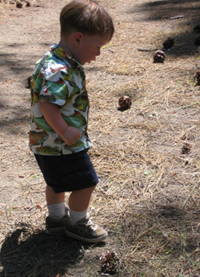Nature Mysteries
463 words
How to help young brains grow in curiosity and wonder
by Dianne Roth
One of the things I dearly loved about teaching was posing “Nature Mysteries”. I point out something that on the surface doesn’t make sense, and ask the children to come up with theories about why.
At first, they hesitate to share their ideas. It is risky to speculate about things you know nothing about. First graders already know from experience that to be wrong often carries grave consequences. You get ridiculed or worse if you say something silly.
I love to plant curiosity and wonder. They create brain dissonance which drives discovery. Once a mystery is noticed, the inquiring mind continues looking for understanding and “Ah-ha!” comes in a flash of knowing. Hopefully, we all have experienced those moments.
My grandchildren live on a river. Over the seasons, I noticed the water changing colors. I have seen it blue, green, brown, and nearly black. Why?
My oldest grandson’s first guess was, “I don’t know,” and he was finished.
I am convinced that if we see teaching as simply imparting knowledge, we have children that never learn to notice, or question, or hypothosize.
I insisted there must be a reason and I believed he could figure it out. It took him a year.
The important thing is, I never judge the hypothosis. Right or wrong, I say, “Hmmm...,” and add things like, “Could be,” “I hadn’t thought of that,” “Interesting!” “Good ideas!” Notice there is no clue to right or wrong.
His early guesses were tentative, sort of mythological and cartoon-ish. Then, one day he said, “Gram, I know why the river is brown.” He explained it with confidence. Of course I beamed!
This only works if we stop seeing ourselves as “knowledge dispensers”. Instead, I like to think of myself as a learning facilitator or discovery guide.
We live in a richly interesting world. Our journey is to notice and wonder, and really savor all the little bits of not knowing we encounter.
There are mysteries everywhere, keep your eyes open and your mind inquisitive.
Other mysteries:
Why, in the winter when it is cloudy, can it be warm; but when the sun is shining, it can be very, very cold?
Why, when it rains hard do all the worms come out on the sidewalk?
Why is the moon sometimes round and sometimes like a cookie with a bite out of it?
When my mother was a little girl, she was lowered into a well in the middle of a sunny day. She looked up and saw stars! How could that be?
Where does rain come from? Clouds? Then, where do clouds come from?
How do great big rocks in the woods get cracks in them? (My six year old granddaughter says it is because kids jump on the rocks.)
Enjoy!
Dianne Roth is a teacher, mother, grandmother, and freelance
writer. She lives in Oregon.
|


